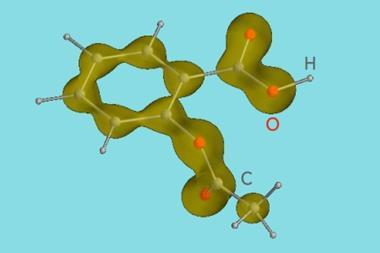A method to distinguish between polymorphs, which is important for drug design, involves making dents in the polymorphic crystals using a sharp implement
Scientists from India and Denmark have found a way to go one better than x-ray crystallography to examine pharmaceutical crystals at an even deeper level. Their method could be used to distinguish between polymorphs - different crystal forms - of a compound to aid in drug design.
The team, led by Upadrasta Ramamurty and Gautam Desiraju from the Indian Institute of Science, Bangalore, and Andrew Bond from the University of Southern Denmark, have used nanoindentation to analyse two different polymorphs of aspirin. Polymorphs are crystals of the same compound but with a different molecular arrangement. Although two crystals may appear similar in structure, they can have dramatically different properties, and many drugs only receive regulatory approval for one form. ’One of the current areas of research is trying to link crystal properties to crystal structure and to try to understand how polymorphism occurs,’ says Bond.
Attempts to investigate the mechanical properties of crystals using indentation have been limited by the need to grow crystals large enough to analyse. ’The key to using nanoindentation is that we can look at crystals on the scale that we can actually make them,’ says Bond. The technique involves depressing a nano-sized tip into the crystal. The researchers then measured the imprint left in the sample to determine the material’s mechanical properties, such as plasticity and elasticity (how easily a substance is deformed permanently and non-permanently, respectively).

The team discovered that two polymorph crystals of aspirin, which appeared to be pure by x-ray crystallography, in fact contained a mixture of the polymorph types. ’What I found most interesting was the idea that the mechanical properties measured by nanoindentation are a very sensitive way of determining polymorphic composition and identifying domains of one polymorph in another, which crystallography can’t see,’ says Roger Davey who studies polymorphism at the University of Manchester, UK. ’This is indeed of interest to formulators who need pure forms.’
Nanoindentation could have an impact on the pharmaceutical industry, which currently relies on x-ray crystallography to establish whether or not a new drug has been made, for intellectual property rights. ’The long term goal is to develop a firm correlation between nanoindentation responses and crystal structures,’ says Bond.
Fiona McKenzie
Link to journal article
Interaction anisotropy and shear instability of aspirin polymorphs established by nanoindentationSunil Varughese, M. S. R. N. Kiran, Katarzyna A. Solanko, Andrew D. Bond, U. Ramamurty and Gautam R. Desiraju,?Chem. Sci., 2011, 2, 2236DOI:10.1039/c1sc00430a







No comments yet